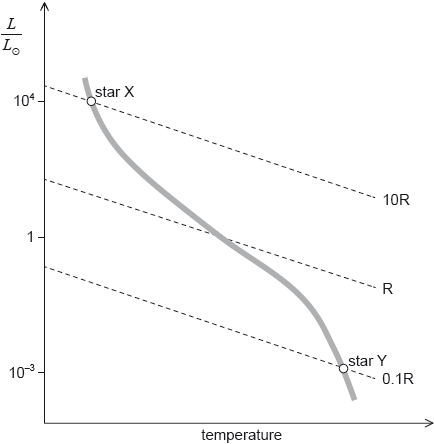| Date | May 2019 | Marks available | 2 | Reference code | 19M.3.SL.TZ2.13 |
| Level | Standard level | Paper | Paper 3 | Time zone | 2 |
| Command term | Outline | Question number | 13 | Adapted from | N/A |
Question
The following data are available for the Cepheid variable δ-Cephei.
Peak luminosity = 7.70 × 1029 W
Distance from Earth = 273 pc
Peak wavelength of light = 4.29 × 10–7 m
Outline the processes that produce the change of luminosity with time of Cepheid variables.
Explain how Cepheid variables are used to determine distances.
Determine the peak apparent brightness of δ-Cephei as observed from Earth.
Calculate the peak surface temperature of δ-Cephei.
Astronomers claim to know the properties of distant stars. Outline how astronomers can be certain that their measurement methods yield correct information.
Markscheme
Cepheid variables expand and contract
OR
Radius increases and decreases
OR
Surface area increases and decreases ✔
Surface temperature decreases then increases✔
Surface becomes transparent then opaque ✔
OWTTE
Do not reward ‘change in luminosity/brightness’ as this is given in the question.
Accept changes in reverse order
the «peak» luminosity/actual brightness depends on the period
OR
More luminous Cepheid variables have greater period✔
measurements of apparent brightness allow distance determination
OR
Mention of ✔
OWTTE
«m» ✔
«Wm–2» ✔
«»
=6800«K» ✔
Data subject to peer review/checks by others ✔
Compare light from stars with Earth based light sources ✔
measurements are corroborated by different instruments/methods from different teams ✔
OWTTE
Examiners report
The expansion and contraction of Cepheid stars was commonly mentioned. Changes in surface temperature and opacity were less commonly mentioned. A common misconception seems to be that the variation of luminosity is due to a change of the rate of fusion. A few candidates left this question unanswered.
Many candidates knew that if the luminosity of the Cepheid is known then the absolute brightness can be used to determine distance. But far fewer candidates could link luminosity with the period of the Cepheid star. Many seemed to think that the luminosity of all Cepheids is the same.
Calculating the brightness of a star from its luminosity was an easy question for most candidates. But quite a few did not convert parsecs into metres especially at SL.
This simple calculation using Wien’s law was very well answered.
Many candidates correctly stated that astronomers can use peer review or different methods in checking that the information obtained from stars is correct.


